Sage sparrows and a rock wren were caught foraging through, and a new kangaroo rat moved in.
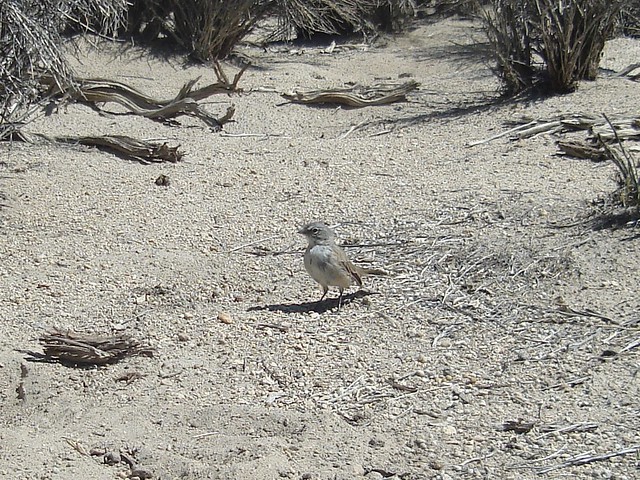
Sage sparrow in the pygmy rabbitat
Much like sage thrashers, sage sparrows are common to the sagebrush scrub habitat, and I often see them zipping around like mice as they run from shrub to shrub.

Sage sparrow on the move with tail held high
Have to admit, I'm quite fond of any sparrow that makes itself easy to ID to species.
The rock wren is interesting. Pretty open, flat, un-rocky terrain for them. I'm wondering if the Brachylagus burrows are the main attraction. I started dabbling with an HD video cam trap in the rabbitat, and while the footage isn't worth reporting yet, a couple of clips suggest the rock wrens are going down into the pygmy rabbit burrows. I'm guessing to hunt insects, not unlike the "dumpster diver" birds that prowl mountain beaver burrows and debris piles.

Rock wren near burrow, standing on the infamous dust-bowl stick after it was moved
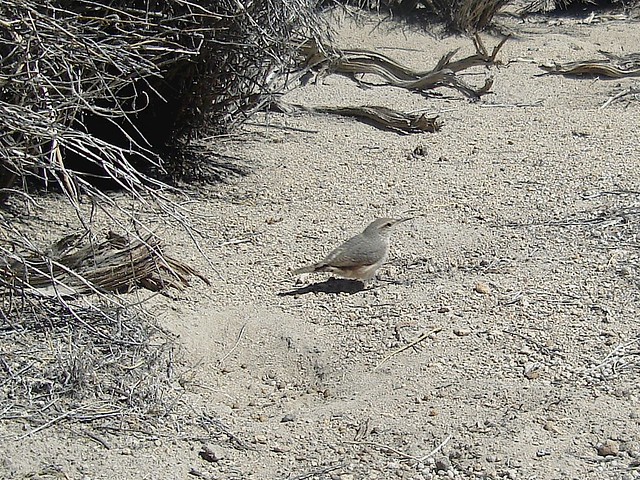
Rock wren dashing off
In the 1st round at this set, a kangaroo rat with a chewed tail was caught coming and going 7 times in the first 19 days. But then was never seen again.
As mentioned, in the 3rd round, 91 days later, a new k-rat moved in.
And sometimes flew in too.
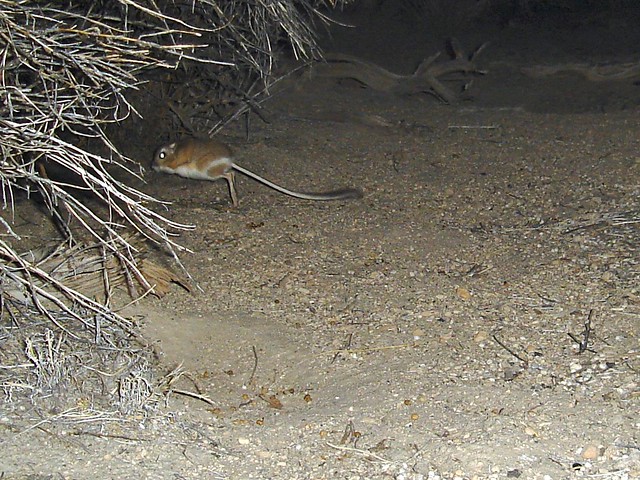
Kangaroo rat heading into pygmy rabbit burrow
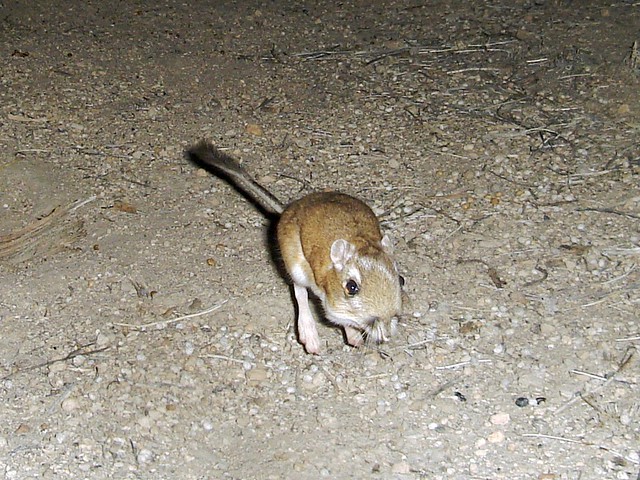
And hopping by the cam trap
Oh - and that young coyote came by a few more times too. Pretty sure it's the same one.
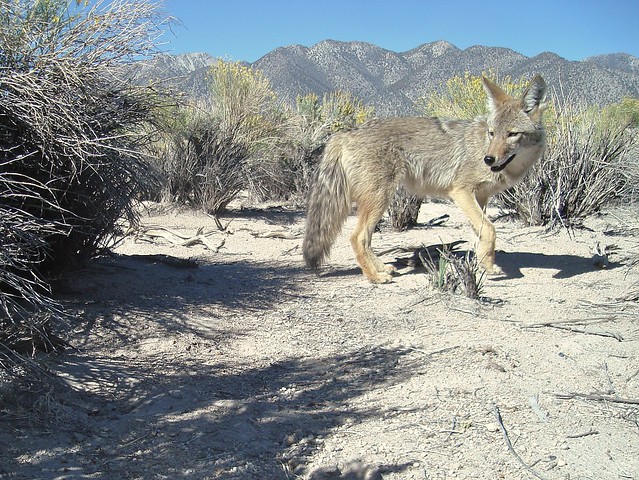
Young coyote looking at pygmy rabbit burrow
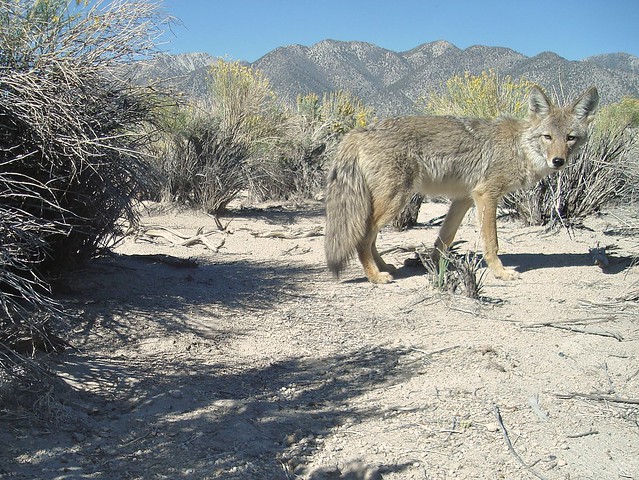
And then at the cam trap - "What are you looking at?"
Since these 3 rounds are likely the last for this year, here's a summary of the activity to-date.
Aside from the pygmies, 10 other species visited the bunny zone during the 3 reset rounds, which had 27, 37 and 38 active days each, for a total of 102 days of rabbitat monitoring out of 139 possible. The 37 missing days between rounds 1-2 and 2-3 - a filled memory card and dead batteries.
Species captured by camera in order of visit frequency:
| Animal | Individuals | Visits |
| Pygmy Rabbit | 5+ | many |
| Black-tailed Jackrabbit | 3+ including juvenile | 42 |
| Kangaroo Rat, likely Ord's | 2+ | 16 |
| Deer Mouse | 2+ | 12 |
| Chipmunk, likely Least | 2+ | 11 |
| Sage Thrasher | 2+ including juvenile | 8 |
| Sage Sparrow | 1+ | 5 |
| Coyote | 1+ | 5 |
| Piute Ground Squirrel | 2 | 1 |
| Rock Wren | 1 | 1 |
| Toad, likely GB Spadefoot | 1/2 | 1 |
Of the above, the k-rats, deer mice, chipmunks and toad are almost surely residents to the near area, living in and between active or old pygmy rabbit burrows.
1/2 of the black-tailed jackrabbit visits were from that single juvenile, which may have been birthed in a burrow in the complex, and thus was more resident than transient for the first round.
The Piute ground squirrel pair was just passing through, and the 3 birds and coyote - opportunists.
Species that might be in the area but weren't caught? Maybe bobcat, badger, weasel, cottontail, antelope ground squirrel, Great Basin pocket mouse… On the bird front it would be nice to see sage grouse wander through, or green-tailed towhees. And if a photogenic prairie falcon wants to plunge down and take a rabbit right in front of the cam - so be it.
I'm obviously looking forward to seeing what next season holds.
====
References:
- Nature of a Man (this blog) - Dust-Bathing Beauties
- Nature of a Man (this blog) - Jealous Jacks
- Nature of a Man (this blog) - I Brake for Brachys
- Nature of a Man (this blog) - Splitting Hares
- Nature of a Man (this blog) - Pygmies of the Great Basin
- Nature of a Man (this blog) - From A to Zapus

That's a good-lookin' coyote! beautiful tail
ReplyDeleteAw... this was (and has been) delightful. I have SUCH a soft spot for that kangaroo rat face. I don't know WHAT it is about that unusual melon-shape, but I find it totally beguiling. So many great, clear shots of wildlife w/a great background.
ReplyDeleteLooking forward to next year's batches. =) That's a great thing about wild life: you never know what's next.
I got to watch a juvenile rock wren in my farmyard for about 3 weeks. It spent a lot of time poking in and out of nooks and crannies of old buildings, junk piles, and under boards. Maybe when they are dispersing, they drop out of the sky to investigate structurally complex habitat like this sagebrush stand. Gives one greater appreciation for gnarly dried up scrub.
ReplyDeleteThat would be a solid theory, but this "sagebrush stand" is pretty much uniform with a bush ever few feet for over a mile in every direction. As is the next valley, and the next… So I think there must be more to it in the mind and eye of the discerning wren.
DeleteGreat shot of the coyote. The best I've seen with the habitat and the mountains in the background. Wonderful, Ken.
ReplyDeleteDave Rentz
This has been an awesome and fascinating glimpse into this little world... So glad you share it! Fingers crossed for some wandering sage grouse next year.
ReplyDeleteThanks Jen. I did get a handful of mediocre pics of sage grouse hens at another location. Perhaps I'll post them too.
DeleteGreat natural history, Ken. You've made a good sweep.
ReplyDelete